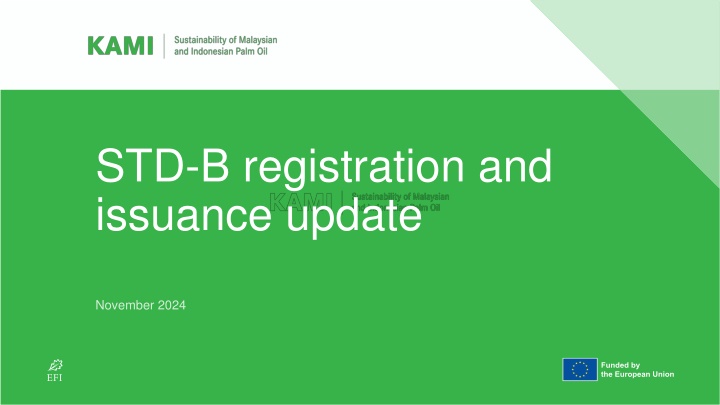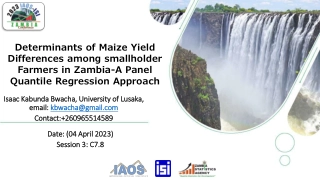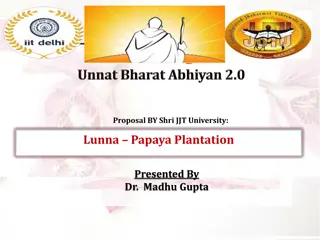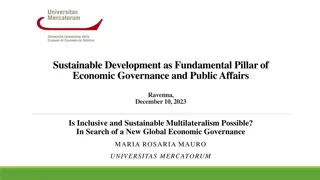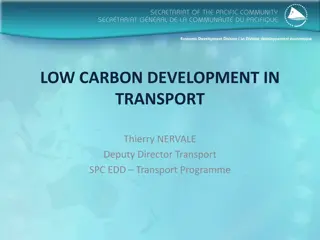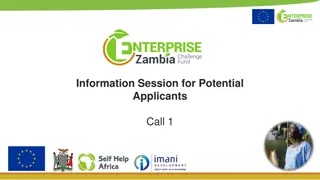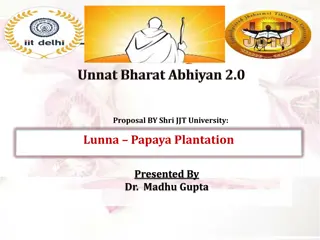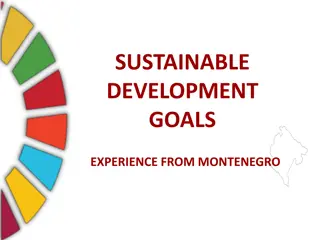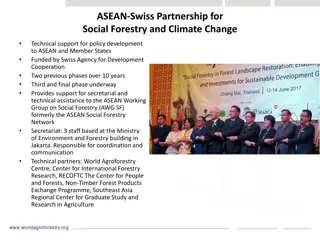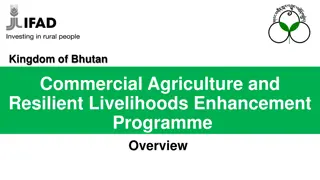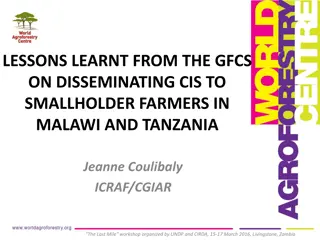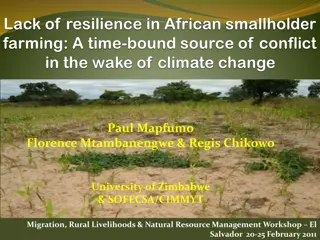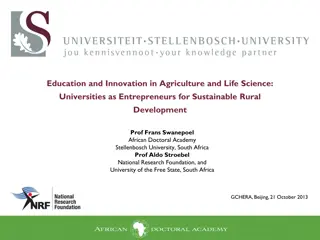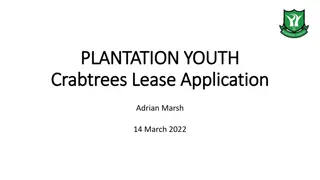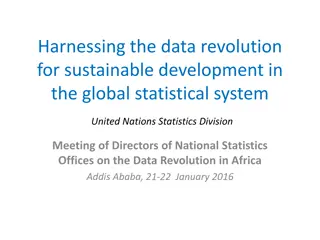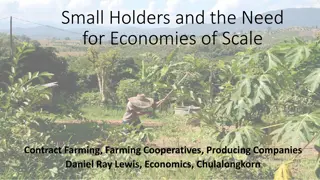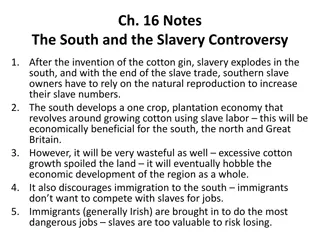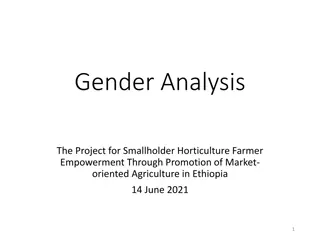Comprehensive Framework for Sustainable Smallholder Plantation Development
STD-B, a cultivation registration certificate, is crucial for smallholder producers of palm oil and other plantation commodities. It provides essential information to local governments and supports sustainable smallholder plantation development through data collection, assistance distribution, governance promotion, and more. However, challenges such as bureaucratic processes, resource limitations, high costs, and lack of understanding hinder its issuance and migration to e-platforms.
Download Presentation

Please find below an Image/Link to download the presentation.
The content on the website is provided AS IS for your information and personal use only. It may not be sold, licensed, or shared on other websites without obtaining consent from the author.If you encounter any issues during the download, it is possible that the publisher has removed the file from their server.
You are allowed to download the files provided on this website for personal or commercial use, subject to the condition that they are used lawfully. All files are the property of their respective owners.
The content on the website is provided AS IS for your information and personal use only. It may not be sold, licensed, or shared on other websites without obtaining consent from the author.
E N D
Presentation Transcript
STD-B registration and issuance update November 2024
What is STD-B? A cultivation registration certificate for smallholders with land < 25 hectares, issued by the Regent or Mayor Purpose: to provide local governments with information about farmers plots, socio-economic conditions and productivity, and to allow better targeted extension services to smallholders A basic legal requirement for smallholder producers of palm oil and other plantation commodities A key requirement for obtaining Indonesian Sustainable Palm Oil (ISPO) certification STD-B is not: a license a vehicle to collect extensive data
Importance of STD-B STD-B offers a comprehensive framework for sustainable smallholder plantation development through: Collecting data on smallholder plantation ownership, to support policy making Identifying prospective smallholders for the distribution of government assistance Promoting the governance of smallholder-owned sustainable plantation crop cultivation businesses Strengthening smallholder / village institutions to increase smallholder productivity and welfare Encouraging good agricultural practices at the smallholder level Ensuring plantation-based natural resources are managed sustainably Supporting traceability of plantation commodities Providing information relevant for meeting global market requirements for legal and deforestation-free commodities (e.g. EUDR)
Progress of STD-B (October 2024) Smallholder registration: Oil palm: 2.52 million smallholders, 2.64% have STD-B Rubber: 2.14 million smallholders, 0.04% have STD-B Coffee: 1.85 million smallholders, 0.05% have STD-B Cocoa: 1.61 million smallholders, 0 have STD-B Total e-STDB issued/in progress: Smallholders: 114,473 Plantations: 139,437 Total area covered: 467,646 hectares
Challenges to STD-B issuance Overly bureaucratic and burdensome process Insufficient human/financial resources in districts to process STD-B (data collection, verification, issuance) High cost of data collection for STD-B issuance (IDR 400.000 500.000 per hectare) Lack of understanding on how to migrate STD-B documents into e-STD-B platform Each region has different requirements for STD-B issuance (proof of PBB payment, statement of space suitability, NIB, etc.) Tenure legality issues (plantations in the forest area, with overlapping land use permits, lacking proof of land ownership, etc.) Insufficient understanding of STD-B at the district and village levels
New STD-B guidelines Director General of Plantations Decision No. 37/Kpts/PI.400/03/2024 Issued by the Ministry of Agriculture in May 2024; immediate implementation Aim: to simplify and accelerate the STD-B issuance process in districts KEY HIGHLIGHTS oe-STDB reinforced as the primary STD-B platform oSimplified/streamlined data collection oShift from physical to digital, e.g. e-STDB, maps/geolocation oFaster process (no more field inspections/verifications) oData collection can be done manually and/or directly in the e-STDB platform
Old vs new STD-B guidelines Chapters / Sub chapters Changes in the revised STD-B Guidelines (2024) Purpose and Objective Additional objective added: to support the establishment of a plantation commodity traceability system Steps include preparation, socialisation, data collection, mapping, verification and issuance. The requirement for field inspections has been removed Procedure for Issuing STD-B Now includes a legal basis for establishing the Data Collection, Mapping and Verification teams, through a Regent/Mayor level Decree Preparations phase - - - - District-level Data Collection team, instead of village level Data collection can be done manually, or directly using the e-STDB Platform Only plantations demonstrating land legality can be recorded Simplified Data Collection Form (reduced from three to one pages) Data Collection
Old vs new STD-B guidelines (continued) Chapters / Sub-chapters Changes in the revised STD-B Guidelines (2024) - - - - - map of forest areas/HGU areas sourced from the relevant institution - Land with Certificate of Land Ownership (SHM) is considered clean and clear , will be directly recommended for STD-B issuance - STD-B can only be issued electronically in the e-STDB platform (no more paper-based STD-B) - Reinforces the e-STDB platform as the platform for storing and publishing information related to STD-B No changes To be conducted at the district level The involvement of third parties is explicitly mentioned The scale of the map revised from 1:2,000 to a minimum of 1:50,000 Must be in the form of geospatial data in digital format (no more paper maps) No more field inspections, only overlay of the plantation location map with Mapping Verification STD-B Issuance Information and Data Management Funding, Incentives, Progress Reporting
New STD-B guidelines: pros and cons Pros: Faster process: no field inspection, less data to collect Digital process: no paper certificates, maps, etc. e-STDB is the primary platform for issuing STD-B: no more duplication between platforms Facilitates data consolidation at the national and provincial levels Cons: Removing field verification increases risk of land with multiple tenure claims / overlap with forest or other protected areas / not matching the reported classification receiving STD-B Some data no longer collected would still be important for various government programmes Lack of qualified personnel to apply the e-STDB platform No physical documents for smallholders (both pro and con) Self-application by smallholders is not yet included in the regulation District-level responsibility could create additional bureaucracy
Challenges remaining Farmers with multiple plots of different legality status cannot get STD-B for their legal plot(s) because they cannot be separated Budget constraints for STD-B acceleration Overlaps between plots and forest area/HGUs remain Tenure legality resolution not addressed in new guidelines
Next steps TARGET: 2.5 MILLION STD-B IN 2024 coordination by Ministries of Agriculture/Home Affairs, funding from APBN (coffee, rubber, cocoa), DBH Sawit and BPDPKS (palm oil), focus on 8.14 million smallholders Socialisation of STD-B in districts/provinces Transferring STD-B documents/information into the e-STDB platform Processing information collected by CSOs/companies/districts for around 400,000 smallholders into STD-Bs Optimising the role of CSOs to support smallholder data collection Ensuring district and provincial budgets have adequate funding for STD-B acceleration e.g. from DBH Sawit, APBN or BPDPKS
Next steps (continued) Making incentives available to smallholders with STD-B (infrastructure assistance, priority replanting, support to control more competitive FFB prices, funding support, etc.) Tenure legality clarification Training staff in the regions in the use of the e-STDB platform Considering ways to link STD-B to ongoing traceability efforts/tools to create incentives and accelerate data collection Allowing self-application for STD-B to be made directly by smallholders
